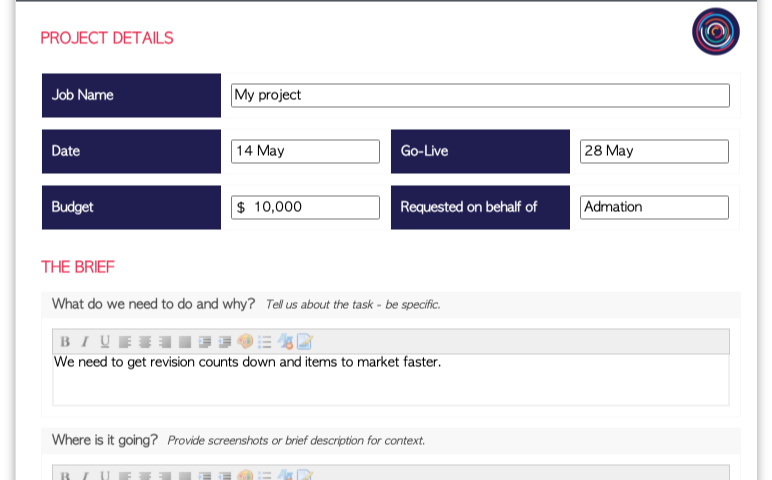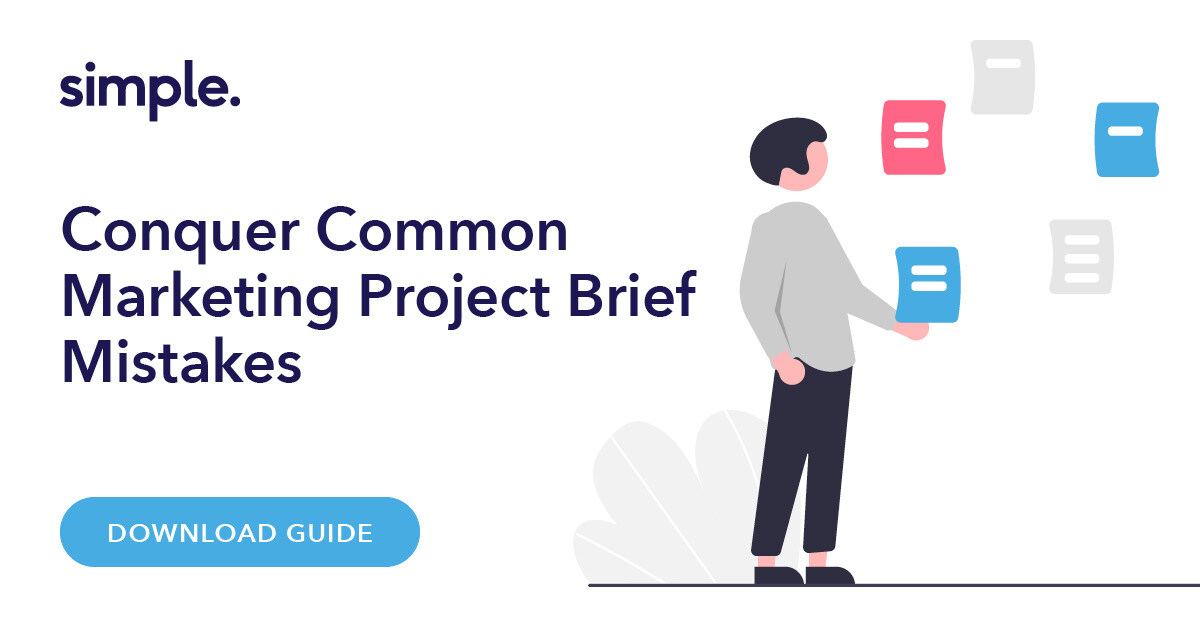How to Write the Perfect Marketing Brief in 13 Essential Steps
By Jodie Byass
Introduction: The Power of a Well-Written Marketing Brief
Its well known across the industry that getting the right message in front of the right audience is crucial. A marketing brief is much more than a simple list of instructions—it is a strategic document that bridges the gap between a campaign’s goals and the creative execution required to achieve them. Utilising a brief template provides structured frameworks for marketing campaigns, facilitating organisation and communication among team members, ultimately streamlining the campaign development process and ensuring that essential information is captured for effective execution. As the main tool marketers have at their disposal, a well-crafted marketing brief ensures that all stakeholders, from internal teams to external agencies, are on the same page, aligned with campaign objectives, and clear on their roles.
A great marketing brief isn’t just about getting creative assets completed; it’s about understanding the target market, knowing the pain points your product solves, and delivering a message that resonates. When the marketing team takes the time to define a clear brief, they save time, reduce costs, and create a foundation that empowers the creative team to build compelling, on-brand campaigns. A solid brief offers clarity on each element of the project, including budget, timelines, and key milestones, which keeps the project on track and aligned with the business’s overall marketing strategy.
Throughout this guide, we’ll cover the essential elements of a high-impact marketing brief, with insights into how each part contributes to a successful marketing campaign. From project details to measurable results, following these steps will equip you with everything needed to develop campaigns that not only meet but exceed your goals.

Understanding the Importance of a Marketing Brief
A marketing brief is a crucial document that outlines the objectives, strategies, and tactics of a marketing campaign. It serves as a blueprint for the campaign, ensuring that all stakeholders are on the same page and working towards the same goals. A well-crafted marketing brief is essential for a successful marketing campaign, as it helps to clarify roles and objectives, establish measurements for success, and align the marketing team and stakeholders.
Unlike a creative brief, which focuses on the “what” and “why” of a marketing campaign, a project brief delves into the “how” and “when.” It provides a comprehensive overview of the campaign’s strategic direction, ensuring that every aspect of the campaign is meticulously planned and executed. By understanding the importance of a marketing brief, marketers can create effective campaigns that drive results and achieve their goals.
1. Project Details
The first step in crafting a marketing brief is to provide basic yet essential project details. These details create a framework for the marketing campaign, allowing all involved to understand the scope, timeline, and roles. Including this information upfront reduces the likelihood of confusion and keeps the project organised from start to finish. A campaign brief outlines the goals, strategies, and essential details for marketing campaigns.
In this section, include:
- Project Name: A clear name helps all team members quickly identify the campaign.
- Brand or Product: Specify which product, service, or brand the campaign will focus on.
- Timeline: Outline major deadlines, from draft due dates to final approval and launch dates.
- Requestor and Approvers: Identify who is requesting the campaign, who will review it, and who has final approval authority.
Including these foundational details keeps everyone aligned on what needs to be done, by whom, and by when.
2. Channels
Choosing the right channels for a marketing campaign is essential for reaching your target market effectively. This section of the brief allows the marketing and creative teams to plan appropriately for each channel’s unique requirements as part of a well-defined creative strategy. By listing the primary channels for your campaign, you clarify the campaign’s direction and avoid wasted resources on channels that don’t align with the audience.
If you know you’ll be focusing on social media, digital ads, email, or print, list these channels here. The chosen channels should reflect the campaign strategy and align with where your target audience is most active.
3. Proposed Budget
The budget is one of the most critical elements of a marketing brief, defining the campaign’s overall scope and feasibility. It’s important for the marketing team to be clear about what resources are available, as this will guide the creative team in determining the scale and ambition of their work. Additionally, creative team members need to understand the budget to determine the scale and ambition of their work.
By setting a realistic budget in the brief, you reduce the chance of overspending or costly revisions. Connect the budget to campaign objectives to ensure funds are allocated wisely and expectations are managed from the beginning.
4. Product Details
Outline the product or service being marketed to give the creative team a clear understanding of what makes it unique. This section should include:
- Product Features and Benefits: List key selling points.
- Unique Selling Proposition: What makes the product different from competitors?
- Target Market Pain Points: Describe the specific challenges or needs the product addresses.
Including this information allows the creative team to craft messages that align with the target audience’s needs and present the product as the solution. Using a marketing brief template helps ensure all relevant product information is captured.

5. Commercial Context and Marketing Strategy
The commercial context provides essential background information, making it easier for the creative team to align the campaign with the business’s goals and the competitive landscape. In this section, explain:
- Business Opportunity or Goal: What is the desired outcome for the business?
- Campaign’s Strategic Importance: How does this project align with company objectives?
- Competitive Landscape: Provide competitor information to position your product effectively.
A marketing campaign brief helps guide and streamline various marketing projects.
Knowing the commercial context allows the team to focus on what matters most, leading to a more relevant and effective campaign.
6. Audience Information
The marketing brief should outline the target market in detail. Describe the demographics, behaviours, and preferences of both the primary and secondary audiences. For an even deeper understanding, include audience insights such as:
- Core Needs or Pain Points: Describe what problems the audience is trying to solve.
- Motivations and Values: What drives this audience? What are their beliefs?
- Psychographics: Include lifestyle, interests, and buying habits for a fuller picture.
Marketing campaign briefs are essential tools for outlining the goals, strategies, and execution plans for campaigns.
The more the creative team understands the target audience, the better they can tailor messages that will resonate and drive the desired action.
7. Desired Actions
Specify the actions you want the audience to take after engaging with the campaign. Whether you want them to sign up, make a purchase, or engage with your brand on social media, be clear about the primary objectives. A marketing campaign brief template helps structure the desired actions and ensures all relevant information is captured.
These actions should support the broader marketing strategy, making it easy for the creative team to understand and work towards the intended outcome.
8. Insight into the Target Audience
Provide an insight that explains the audience’s motivations, going beyond demographics to answer the ‘why’ behind their actions. Audience insights can transform the creative process, guiding the team to develop concepts that are authentic and meaningful. Creative briefs focus on guiding the development of creative assets like imagery and videos.
For example, if the target market values sustainability, focus the campaign around eco-friendly aspects. An insight like this allows the creative team to tap into a message that resonates on a deeper level, driving stronger engagement.
Defining the Campaign Background
Defining the campaign background is a critical step in creating a marketing brief. This section should provide context for the campaign, including the brand or organiszation behind the campaign, the desired outcomes, and the scope of the campaign. The background of the campaign should clarify the brand’s goals and objectives, as well as the timeline, key milestones, and key stakeholders involved.
By defining the campaign background, marketers can ensure that all stakeholders are aware of the campaign’s purpose and goals, and can work together to achieve success. This section should also outline the target audience, including demographics, behaviors, and pain points. By understanding the target audience, marketers can create campaigns that resonate with them and drive results.
9. Core Communication Idea and Creative Brief
The core communication idea or single-minded proposition distills the campaign’s central message. This section should clarify the main point that you want to communicate to the audience and how this aligns with the brand’s identity.
This single-minded proposition provides focus, making the campaign more cohesive and helping it stand out. When all messaging elements tie back to this core idea, the audience will have a clearer understanding of the brand and product.
10. Brand Guidelines
Provide brand guidelines to ensure consistency across all creative assets. These guidelines should cover:
- Brand Colours, Logo, and Fonts: Specify approved visuals.
- Tone and Style: Define the brand voice to ensure the messaging aligns with the company’s identity.
- Imagery Style: Specify any preferences for imagery treatment or visual style.
Following brand guidelines maintains consistency, helping build brand awareness and strengthening the brand’s presence in the market.
11. Mandatories
This section includes elements that must be in every creative asset. Mandatories often include:
- Legal Disclaimers: Essential for compliance.
- Calls to Action: Specifics about how to guide the audience’s next steps.
- Key Taglines or Slogans: Consistent language that reinforces brand identity.
Defining these mandatories in the brief saves time and ensures every aspect of the campaign meets internal requirements.
12. Measurable Results
Specify the metrics that will measure campaign success. Common KPIs for marketing campaigns include:
- Brand Awareness: Increases in social mentions, shares, and brand searches.
- Engagement: Click-through rates, likes, comments, and shares.
- Conversions: Sales, sign-ups, or other direct actions.
Measuring success through clear metrics allows the marketing team to assess the campaign’s effectiveness and optimise future campaigns.
13. Stakeholders and Roles
A high-impact marketing brief identifies all stakeholders involved in the project, making sure roles are clear and everyone knows their responsibilities. Include both internal and external stakeholders, covering their specific roles and how they contribute to the project.
Internal Stakeholders
- Marketing Team: Leads campaign development, manages objectives, and oversees execution.
- Creative Team: Designs, writes, and produces the campaign assets.
- Product Team: Provides product-specific insights that shape the campaign messaging.
- Compliance and Legal: Ensures materials comply with regulatory standards.
- Sales Team: Adds insights on customer feedback and competitive positioning.
External Stakeholders
- Agencies: May include advertising, PR, or media-buying agencies.
- Vendors and Suppliers: Handles production and logistics if applicable.
- Media Partners: Essential for campaigns with significant paid media components.
Clear stakeholder roles reduce ambiguity and improve collaboration across teams, keeping the campaign focused and efficient.
Best Practices for Marketing Briefs
Best practices for marketing briefs include creating a clear and concise document that outlines the campaign goals and objectives, target audience, marketing strategy, and tactics. The brief should be tailored to the target audience and should include a clear and concise summary of the campaign goals and objectives.
The brief should also include a timeline, including hard and soft deadlines, and a budget outline, including expenses and resources. By following these best practices, marketers can create effective marketing briefs that drive results and achieve their goals.
Additionally, marketers should ensure that the brief is reviewed and approved by all stakeholders, including the marketing team, creative team, and clients. This will ensure that everyone is on the same page and working towards the same goals.
By following these best practices, marketers can create marketing briefs that are effective, efficient, and drive results. A well-crafted marketing brief is essential for a successful marketing campaign, and by understanding the importance of a marketing brief, defining the campaign background, developing a winning strategy, and following best practices, marketers can create campaigns that achieve their goals and drive results.
Leveraging Technology and Online Briefing for a Streamlined Process
Using technology for creating and managing briefs has become an industry standard, replacing static Word documents and spreadsheets with dynamic, collaborative platforms. Online briefing tools offer flexibility, consistency, and control, giving marketing teams and creative teams alike the advantage of working from a single source of truth. Marketing brief templates help document and manage various marketing campaigns.
Online briefing and template often feature mandatory fields that ensure no critical information is missed. Approved briefing templates for different project types or campaigns make it easy to customise briefs to meet specific needs while maintaining a standardised format. With online tools, it’s easier to align the brief with approval workflows and real-time updates, making the entire process smoother, faster, and more effective.
Key benefits of using online brief solutions include:
- Real-Time Collaboration: Online platforms allow stakeholders to contribute in real time, streamlining feedback and revisions.
- Version Control: Automated updates prevent issues with outdated versions, ensuring everyone is working on the most current document.
- Approval Tracking: Tracking approvals within the system offers transparency and accountability.
- Efficiency: Teams can avoid the delays caused by manual updates and fragmented communication, instead focusing on creative output and strategic impact.
Platforms like Simple’s marketing project management software are purpose-built to manage these aspects effectively, centralising campaign briefs and enabling seamless communication.
Case Study: Enhancing the Briefing Process at Tourism Australia with Admation
Tourism Australia, the agency dedicated to promoting Australia as a premier travel destination, faced challenges managing growing project volumes and increasingly complex campaigns. Previously, the team relied on a shared email inbox to receive project briefs, but this process lacked structure, resulting in inconsistent brief quality and limited visibility across projects. Without a standardised format, brief details were often incomplete, leading to frequent revisions and impacting campaign timelines.
After adopting Admation in 2016, Tourism Australia streamlined its briefing process with structured templates and a centralised platform. Admation’s templates provided a consistent format for all project types, ensuring each brief contained essential information from the outset. This improvement eliminated information gaps and enabled the marketing team to start projects with clear, actionable details, reducing the need for revisions.
Admation’s online briefing capabilities empowered regional teams across 15 locations to submit detailed briefs independently, while also providing full visibility to stakeholders involved in approvals. This transparency enabled better collaboration, as team members could track project status and adjust resources as needed, resulting in a more efficient and responsive briefing process. The standardised templates and clear workflows offered by Admation have allowed Tourism Australia to manage complex campaigns more effectively, delivering on-brand, high-quality marketing projects with improved speed and accuracy.
Conclusion: Crafting an Effective Marketing Brief
An effective marketing brief is the foundation of every successful campaign, from increasing brand awareness to driving conversions. By incorporating these 13 essential elements and leveraging online tools for consistency and efficiency, your marketing team can develop briefs that guide the campaign seamlessly from start to finish. The result? Campaigns that meet their objectives, resonate with audiences, and drive measurable success.

